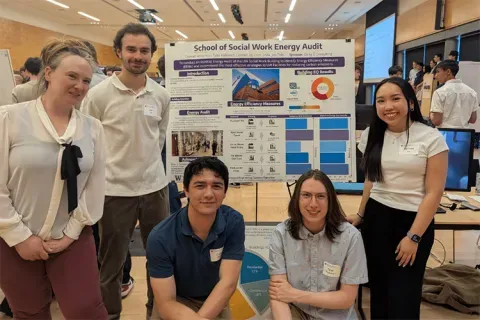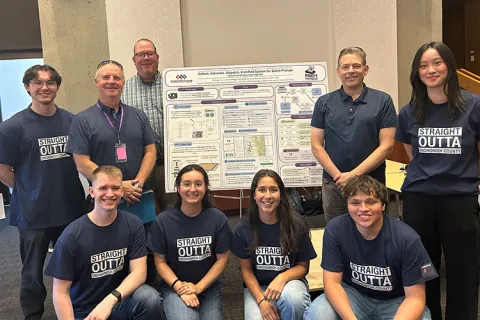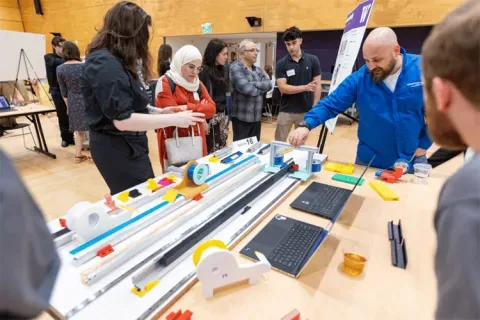Industry-Sponsored Student Capstone Projects
2023/2024
In the 2023/24 academic year, the industry capstone program was supported by 54 sponsors, more than half of which were returning, and 95 real-world projects. Over five hundred fifty students from across the College of Engineering participated. Scroll down to learn more about each project.UW Housing and Food Services
Emergency Dining Management Plan
In the event of a catastrophic event, UW Housing and Food Services (HFS) maintains a responsibility to feed those living in residence or remaining on campus . HFS’s position is that they have a responsibility to take care of their own population first, then support the campus community. They currently have an agreement in their US Foods and Harbor Wholesale contract that will guarantee the delivery of enough shelf-stable food and beverage to support feeding approximately ten thousand people for a 3-day period. This student team will work to establish an Emergency Dining Management Plan, which defines the logistics of organization, preparations, and distribution of food, based on the availability of the facilities and resources. The plan can assume loss of all power, gas, and water utilities, though other scenarios should be considered. At a minimum, this student team will work to help HFS solve for the following: > Human resources- people to do the work, support teams- clarity of roles and responsibilities > Scale staffing to respond to the event (determine who’s here and/or who can get there to help execute the emergency plan) > Storage of food and water - Solar powered refrigeration? >Distribution of “care-packages” of water and snacks > Determine what viable food service can be executed, inclusive of shelf-stable items (high calorie, nutrient dense) > Disposable wares for service, manual equipment (can openers…etc.) > Food safety/sanitation/wastewater containment (bodily function related) > Emergency supplies outside of food This student team will work to deliver a plan that supports the safe and organized logistics of caring for HFS's resident population and supporting staff in the event of a catastrophe. This student team will work to provide a detailed outline of roles and responsibilities, scaled staffing, food storage and water storage and distribution, viable food service outside of RTE (ready to eat) foods, "base camp" kitchen necessities (disposable wares, can openers, paper goods), sanitation/waste water removal (bodily function), and emergency products outside of food- first aid, flashlights, PPE.

UW Medical Center
Modeling Patient Throughput Across Diverse Phlebotomy Settings to Decrease Wait Times
Drawing blood from patients for laboratory testing, or phlebotomy, is one of the highest volume procedures performed in health care. Providing these services depends on a number of factors, including physical space, number of workstations, number of draw stations, staff, and efficiency of the processes required to check patients in, identify their laboratory orders, and perform the blood draw safely. There are also challenges with coordinating with clinic schedules: during time periods where clinics have more appointments available there may be a larger number of patients than blood draw capacity. This student team will work with the UW Department of Laboratory Medicine and Pathology to develop robust models to understand patient throughput across the their various blood draw locations and perform simulations that model the impact of changes such as staffing levels, times for specific process steps, and clinic schedules. This student team will work to create a generalizable tool/model that would allow the faculty and leaders who oversee these areas to understand the impact of different operational changes to patient throughput and wait times. This student team will work to assess all of the variables that may impact patient throughput metrics, including physical constraints, workflow steps and their efficiency, and an analysis of how information systems are used in the process. This student team will work to create successful models that accurately predict patient throughput metrics, such as number of patients drawn per unit time or number of minutes per patient, when a change is made to the system. The work product this student team will work to create will be one or more models that can predict with a high level of accuracy (<10% error) phlebotomy metrics that are used by the leadership team to assess the impact of making changes across a variety of blood draw settings, including primary care, specialty care, and hospital locations. Ideally, the work product this student team will work to create will be version controlled and shared with departmental staff who are comfortable with Python and/or R.
UW School of Aquatic and Fishery Sciences
Rugged, High-Frequency Time-Lapse Cameras to Quantify Salmon Migrations
Professor Andrew Berdahl's lab uses computer vision to count salmon for management and to quantify salmon movement to learn more about their behavioral ecology. In principle a camera filming a small salmon stream should be able to provide a count of each salmon that entered and exits the stream along with the date and time. These data would give Professor Berdhal's lab not only highly accurate and cost effective counts but also information on how salmon may be using social information to make more accurate decisions about when and where to migrate. Professor Berdhal has been experimenting with off-the-shelf (e.g., Brinno) time-lapse cameras, but these have several fundamental drawbacks, including too slow frame rate, too low memory capacity too short battery life, and an inability to film at night (when many of the fish migrate). This student team will work to create a custom system that would address all of these issues, which would improve salmon management and contribute to the lab's understanding of how these fish make decisions. This student team will work to create a base design that is a rugged and weatherproof camera system, able to capture continuous imagery (~4 images per second) with a battery and hard drive able to last weeks-months. The student team will work to include a polarizing filter to cut surface reflection and a flash/continuous light source for nighttime images. Upgrades the student team will work to incorporate include an integrated app that: i) streams what the camera is 'seeing' to aid in set up; ii) allows the user to change camera parameters (eg frame rate); and possibly iii) wireless downloading or at least previewing data. Further expansions the student team will work to achieve include a ML system to automatically count fish passing from the captured images (the lab has made some progress on this already). The base deliverable this student team will work to achieve is a prototype of the system described above, but ideally ~10 units.

UW Sensors, Energy and Automation Lab (SEAL)
A wireless sensor system for detection of air leaks
This student team will work to develop practical system with a minimum of two accelerometers that can communicate wirelessly to detect leaks in air lines. The system the student team will work to create should detect vibrations caused by the leak and send a warning signal to a central unit. The performance goals this student team will work to achieve include: - deviation from a linear response no more than 0.5% across its measurement range, - Noise level less than 20 µg/sqrt(Hz) - Cross-axis sensitivity below 2% . This student team will work to the following project parameters: - The student team will work to source individual accelerometers and wireless communication modules and construct a full system. - The student team will work to add data acquisition and signal processing. - The student team will work to minimize size, weight, and cost The student team will first work to conduct experiments with simulation vibrations (does not have to be an air leak). Next, the student team will work to conduct experiments with actual air leaks to get the base line. Finally, the student team will work to conduct a basic double-blind study to see if the system can detect real-life air leaks.

Wright Energy Institute
Micro Battery Design and Development for Specialty Market
The Micro Battery Design and Development for Specialty Market student team will work to resolve some special characters and requirements for the battery designed, which are differentiated from regular batteries currently available on the market. Micro Battery, as the name suggests, has very limited size (volume) so that the specifications for a micro battery needs to be more specific, pinpoint, towards a given application (specialty). For example, with the same micro sized format, one micro battery design may focus on capacity, while the other one may concentrate on maximized instantaneous power (discharge pattern). Therefore, micro battery design involves whole sets of unique theory, principle and practical techniques. Materials are the fundamental components for a micro battery. MSE is a perfect match academically. The project design parameters and performance criteria this student team will work toward are based on each individual product, identified during the initial micro battery application search. This student team will work to provide full product design and prototype cycle. However, the prototype the student team will work to create will be focused on the feasibility verification, such as the power yield of materials under the limit of a given micro battery parameters, and it may not be accurate in terms of physical format. The outcomes this student team will work toward include: 1. Identify and report multiple applications which demand micro batteries as the basic power source; 2. One specific micro battery design for a micro sized flying device, such as a very light and small sized drone 3. One specific micro battery design for a micro sized device immersing into the water, such as a micro sized, self-powered submarine. 4. Specific materials provide high efficiency to connect the positive and negative electrode to the application circuit. 5. Specific method to connect the materials in “4” inside the micro battery.
Related News

Mon, 10/13/2025 | UW Mechanical Engineering
Capstone collaboration leads to award
An ME capstone team received first place for its energy audit of the UW School of Social Work building.

Thu, 07/17/2025
UW engineering students develop smart ballot solution
UW engineering students develop smart technology solution to improve ballot collection for Snohomish County.

Mon, 07/07/2025 | UW Mechanical Engineering
Capstone creations
Students displayed innovative capstone design projects at the 2025 expo.

Fri, 09/20/2024 | UW Civil & Environmental Engineering
Smarter irrigation for a greener UW
A new project combines satellite data with ground sensors to conserve water and create a more sustainable campus environment.